Menu
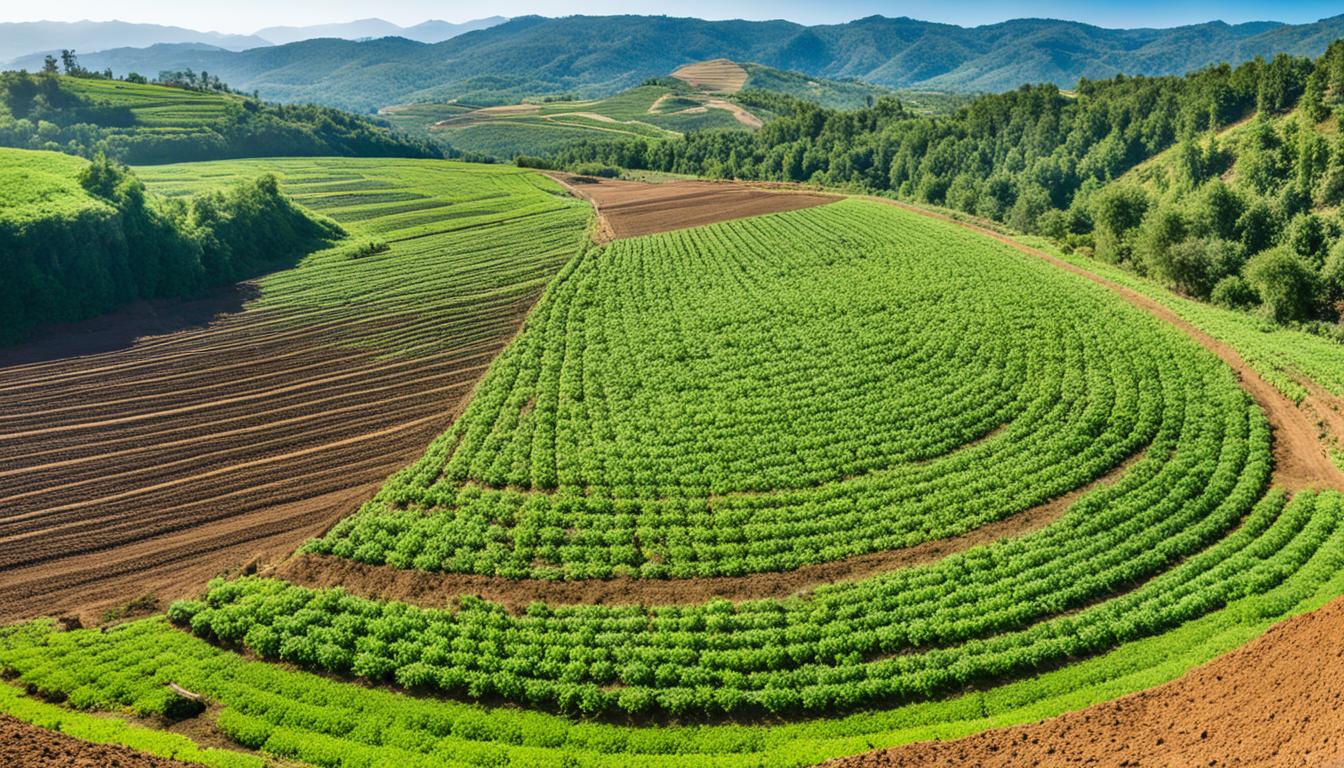
Did you know, 33% of the world’s soil is already degraded? This alarming fact shows why we need to act fast. Soil impacts farming and food, with key players like mycorrhizal fungi. They help plants get nutrients but face threats from bad farming.
Brown earth in Britain is a great example of rich soil. It makes up about 45% of England and Wales. Its deep layers and good drainage help crops grow well. This soil does much more, like purifying water and fighting climate change. It’s key for nature and our buildings too. Saving soil is crucial for everyone’s future.
Soil degradation effects harm the ground’s ability to support life, making it hard to grow food globally. This happens when the quality of soil goes down due to natural causes and human actions. Nutrient loss, erosion, pollution, and farming practices are big parts of this problem.
One key result of soil degradation is that the land can’t produce as much food. This puts our food supply at risk. Things like soil erosion from wind and water, often made worse by farming, are major causes.
At the moment, about a third of the Earth’s soils are in bad shape, and much of this is in Africa. We’re losing a lot of farmland every year, which shows we need to act fast. New technology is helping us keep an eye on soil health and protect it better.
Using better farming methods and taking care of the soil can help a lot. For example, in Honduras, using these methods boosted corn production a lot. The FAO is also helping Africa improve its soil to grow more food. This shows that we can make a big difference by working together.
Fixing soil degradation is crucial for food and nature. It requires everyone to use smart farming and care for the soil to prevent more harm.
Soil degradation is a big threat to our planet, affecting ecosystems, food production, and development. It is vital to fight against this to keep our Earth healthy and productive.
Soil degradation happens when soil quality goes down, making it hard for plants and animals to live. This affects our food, health, and jobs. The earth’s essential cycles are hurt by this problem. For example, it can take 1,000 years to make three centimetres of soil. If we keep going as we are, we might not have good soil in 60 years.
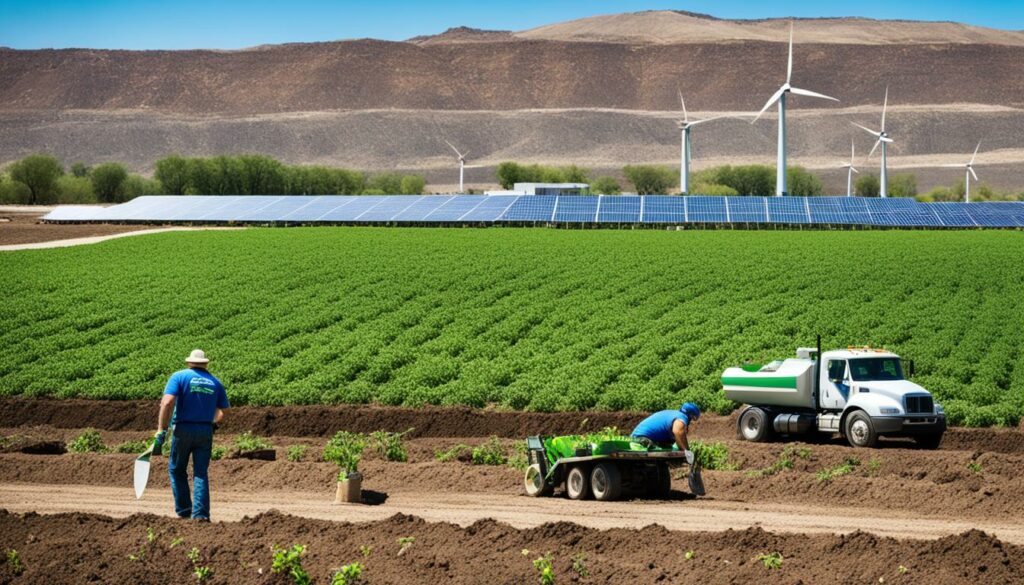
We can group soil degradation into several types. Knowing about these is key to fighting it:
It’s vital to know these soil degradation types to use the right methods to protect soil. For example, we can use things like better farming and planting more trees to tackle several problems at once.
| Type of Degradation | Description | Impact |
|---|---|---|
| Soil Erosion | Displacement of the top soil layer by wind and water forces. | Loss of nutrient-rich topsoil, leading to reduced agricultural productivity. |
| Desertification | Conversion of fertile land into arid regions due to nutrient depletion. | Loss of arable land and severe reduction in crop yields. |
| Salinization | Accumulation of soluble salts in the soil profile. | Soil infertility and decreased agricultural output. |
| Acidification | Decrease in soil pH due to excessive use of chemical fertilizers. | Disruption of soil nutrient availability and microbial activity. |
| Pollution | Contamination of soil with harmful substances from industrial and agricultural sources. | Detrimental effects on soil health, plant growth, and human well-being. |
By understanding different soil degradations, we can focus our fight on what matters most. This way, we can make sure the soil is in good shape for the next generations.
Soil degradation happens for many reasons. It’s vital to know these causes to lessen their impact on the environment and farming. The quality of soil drops due to natural and human actions.
Soil erosion is key in the natural factors affecting soil. Erosion happens from wind and water, removing the topsoil. The UK has over 700 types of soil, including clay, sand, and loam. Each type faces a specific erosion type. For example, peatlands are essential for trapping carbon but are harmed if water levels change. Soil compacts if it gets too wet under heavy pressure.
Humans speed up soil damage through activities like cutting down trees, overgrazing, and too much ploughing. These actions remove plant cover, decrease soil quality, and squash the soil down. Cities and factories make it hard for the ground to soak up water, harming small organisms and causing water to run off. This pollution and damaged soil health affect us all.
Natural and human causes harm the soil and can lead to many problems, including floods, pollution, and less food worldwide. In places like England and Wales where much of the land is good for farming, decreasing soil quality affects food production. Developing countries are hit the hardest, facing serious problems because of less food security.
It’s crucial to use the land sustainably. Maintaining plant cover, stopping erosion, and using smart farming methods are key. These steps help fight soil degradation.
| Type | Factors | Consequences |
|---|---|---|
| Natural Causes | Soil Erosion, Soil Compaction | Loss of soil fertility, habitat collapse |
| Human Actions | Deforestation, Overgrazing, Urbanisation | Pollution, decreased agricultural productivity |
The agriculture sector implications of soil degradation are significant. It reduces crop yields and soil fertility. This shows the urgent need for erosion control methods and regenerative farming practices.
Soil degradation globally reduces crop yields by 20-35% every year. This is because crucial nutrients like phosphorus (P) and potassium (K) are lost. About 50% of these nutrients are in the topsoil which is at high risk of being damaged. Heavy machinery in farming is a big cause, leading to soil compaction and a density reduction to 1.4-1.5 t/m3.
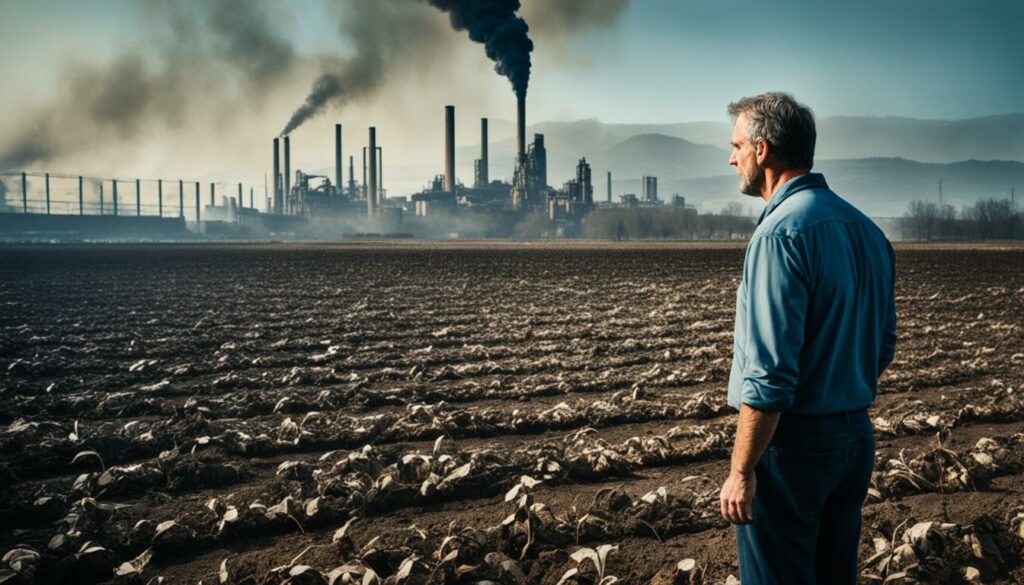
Soil fertility drops a lot due to degradation. Human actions drive 90% of these problems. Bad farming methods, overuse of fertilisers, and expanding urban areas contribute. This damages soil structure and the work of helpful microbes. As a result, soil becomes compact and acidic, making it harder for crops to grow. This means we have less land where we can grow crops.
| Factor | Impact |
|---|---|
| Global Crop Yield Reductions | 20-35% |
| Soil Compaction Density | 1.4-1.5 t/m3 |
| Proportion of Essential Nutrients in Topsoil | 50% |
| Human Activities Linked to Degradation | 90% |
Soil erosion plays a big part in ruining soil, and it’s important to know how it works. In the Midwest, half of all the topsoil has washed away in the last 50 years. This happened because of more farming and building. In 2019, heavy spring rains led to a lot of soil being carried away by water.
The NRCS says that Iowa’s farmlands have lost about 6.8 inches of topsoil since 1850. Strong winds especially hurt dry areas in North America, blowing away tonnes of soil yearly. To stop this, we need to use ways that keep soil in place. About 60% of the washed-off soil ends up in our water, bringing chemicals and pollution. This pollution costs the US nearly $37.6 billion annually in lost earnings.
Stopping soil erosion with specific methods is key to protecting our land. When erosion happens, the most fertile part of the soil goes. This makes the land less able to grow plants. By using smart ways against both water and wind erosion, we can prevent more soil damage.
| Region | Type of Erosion | Estimated Impact |
|---|---|---|
| Midwest, USA | Water & Wind | 50% topsoil loss in 50 years |
| Iowa, USA | Water | 6.8 inches topsoil loss since 1850 |
| Drier regions, North America | Wind | Millions of tons annually |
Sustainable agriculture fights soil degradation by using methods that keep the soil healthy for the long run. It uses conservation practices and methods that help the soil renew.
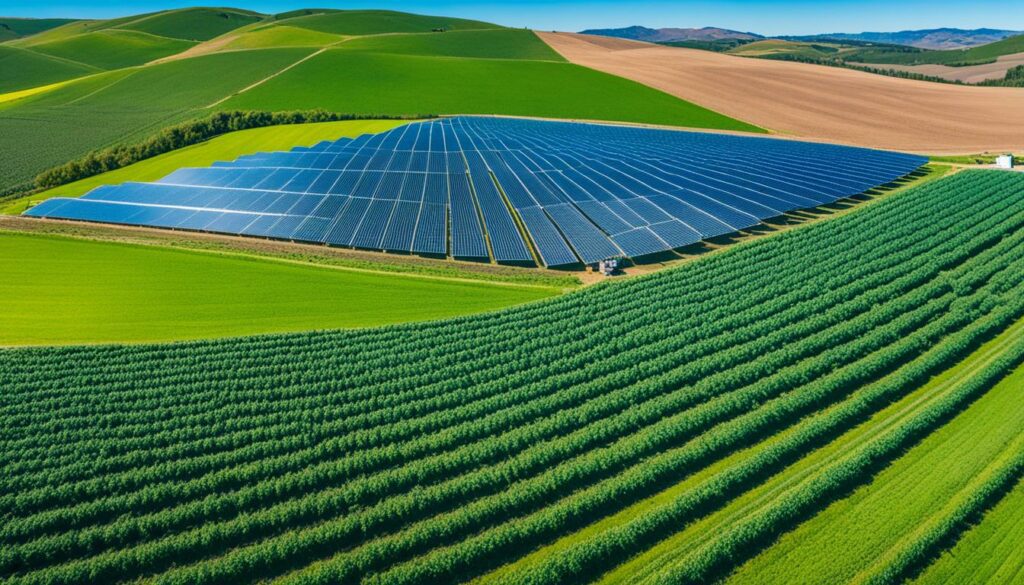
Conservation agriculture is key to sustainable farming. It focuses on three main things: keeping soil disturbance low, always covering the soil, and growing different types of crops. Using no-till agriculture helps reduce soil hardening, which is great for wildlife and keeps the ground more fertile. Windbreaks, made of many trees and shrubs, also slow down the wind. This lessens erosion.
For a long time, terraces have helped in places like southern Europe and Asia. They stop water runoff, reducing soil loss and crop waste. Adding grassed waterways and strips near streams helps catch eroded soil. This saves the land’s fertility even more.
To boost soil health, regenerative farming uses actions like planting cover crops and letting animals graze naturally. Cover crops, like triticale or rye, are put in the ground in winter to stop soil loss. They add healthy stuff to the soil and slow down heavy rain. In California, farmers are planting wildflowers among their crops. This helps the soil and makes more home for bugs.
Multi-species cover crop mixes make the land healthier and support wildlife. Growing different plants together and swapping the types of crops used leads to better soil and fewer pests. Adding legumes to cover crops boosts the soil without needing as many chemicals.
Using integrated pest management (IPM) also helps a lot. It cuts the use of chemical sprays by 40%, but still keeps pests in check. This method fits well with sustainable farming, balancing the ecosystem to help soil and crops.
| Sustainable Practice | Benefits |
|---|---|
| No-Till Agriculture | Reduces soil compaction, minimises erosion, and encourages beneficial microbial life |
| Cover Cropping | Reduces erosion, supports biodiversity, and enhances soil organic matter |
| Integrated Pest Management | Decreases chemical pesticide use while maintaining effective pest control |
| Multi-Species Cover Crops | Increases field-scale biological diversity |
| Crop Rotation | Improves soil health, enhances pest control, and increases crop yields |
| Agroforestry | Increases farm profitability and water resource protection |
It’s vital to use good soil conservation techniques for healthy soil and better farming. These ways stop the soil from getting worse and help farming last for the long run.
Cover cropping plants fields with certain crops just to protect the soil. This helps cut down on soil erosion from rain and wind. It also adds good stuff to the soil, making it better for plants and animals. For example, some cover crops grab nitrogen from the air, which feeds the soil naturally. That’s why cover crops are a big help in making farming less damaging to the earth.
No-till farming is another key way to save the soil. It doesn’t disturb the ground much, keeping the topsoil just as it should be. This is great for letting water in and making room for roots. Like cover cropping, it keeps the soil moist and full of good things. No-till farming doesn’t use much energy, helps against climate change, and is good for farmers’ wallets.
Cover cropping and no-till farming are very important for keeping soil healthy and making farming sustainable. They boost soil health, grow more plants, and help the environment and the economy. These ways prove that we can fight back against soil problems with smart farming. And everyone benefits.
It’s crucial to manage soil erosion well to protect our land. With the right methods, we can fight back against the harmful effects of wind and water. This helps keep our soil productive and our environment healthy. Two top techniques to stop erosion are using vegetative barriers and terracing.
Vegetative barriers are natural shields against soil loss. They’re made of plants or trees that have deep roots. These plants slow down water and weaken wind, making the soil more secure. Around 60% of eroding soil in the U.S. flows into our waterways, causing pollution and harming marine life. Vegetative barriers help cut down this erosion problem.
They also make big rainstorms less damaging. Take the Midwest’s heavy rains in 2019, for example. These storms caused a lot of erosion. But having vegetative barriers could have softened their impact. This would have saved a lot of soil and kept farming areas more productive.
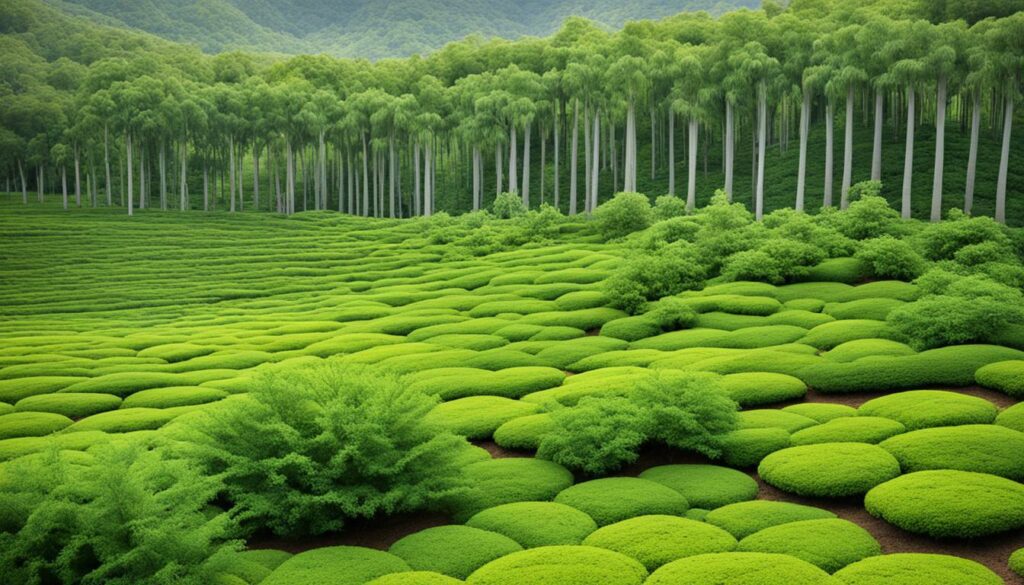
Terracing is great for sloping farms. By shaping the land into steps, it stops water from rushing and carries less soil away. This has worked wonders in places like Iowa. Since 1850, erosion has eaten away 6.8 inches of fertile soil there.
Building terraces helps keep the soil rich, boosting farm output. This is key in the U.S., where soil erosion costs an astonishing $37.6 billion a year. It’s not just about water loss; terracing also fights wind erosion. This saves tonnes of soil, especially in dry parts of North America.
| Erosion Control Method | Benefits | Regions Applied |
|---|---|---|
| Vegetative Barriers | Reduces water runoff, mitigates wind erosion, prevents agrochemical pollution | Midwest, particularly in areas prone to intense rainfall |
| Terracing | Decreases water runoff, maintains topsoil, supports fertility | Hilly regions like Iowa and arid regions in North America |
Agroforestry systems are key in the fight against soil degradation. By combining trees with crops or livestock, they boost soil regeneration and biodiversity. Moving from typical farming to agroforestry can improve soil carbon by 34%. And changing grasslands can increase it by 10% more.
This approach locks away a lot of carbon in both the soil and trees. This helps lessen climate change’s effects. A mix of different plants reduces soil erosion and compaction, which makes the soil stronger. Also, the materials that trees drop, like leaves and branches, add to the earth’s health, aiding in soil recovery.
Agroforestry also boosts soil fertility by using nitrogen-fixing plants, such as leguminous trees. These plants improve the soil directly, making more nutrients for other crops. Trees have deep roots that stop soil issues, like erosion and compaction. They pull up nutrients from under the ground, enriching the topsoil where crops grow.
Creating microclimates is another big plus of agroforestry. These systems protect crops from harsh weather. They also help keep more water and provide homes for various plants and animals. This mix of life is crucial for rich soil and its tiny inhabitants that help keep the ecosystem healthy.
Farmers can get various products from agroforestry, like timber, fruits, and medicinal plants. These provide more than one income source. In some cases, these farming methods can join carbon offset schemes, giving farmers extra money. For areas with animals, planting forage crops and fodder trees means more food for the livestock and more income for the farmer.
Over half of the woods and forests in the United States are in private hands, often on farms or ranches. This shows a big chance to use agroforestry more widely. With the population set to hit nine billion by 2044, we will need more forests and agroforestry to meet the future’s food and resource needs.
Soil degradation is a big global challenge that needs everyone’s effort to tackle. It’s spreading fast, putting our land’s fertility at risk. This affects our ability to grow food, the health of our natural environment, and our efforts for sustainable development. We need to work together to stop and reverse this trend.
Actions like intense farming, using too many chemicals, overgrazing, and cutting down forests harm the soil. They make it salty, acidic, and less fertile, which reduces its quality. To fight this, we must all use farming methods that protect the land. This includes not using too many fertilisers, planting trees, and keeping the environment clean.
New technologies like remote sensing help keep an eye on soil health. They show us which areas need help the most. We’ve already lost a lot of the earth’s ability to store carbon. We must not lose more, for the sake of our soil and the climate.
The world is aiming to grow sustainably, and key groups, like the UN, are helping. They have goals to stop the spread of deserts and to protect our soil. Their plans include teaching people how to farm in a good way and planting trees to help the land.
Understanding how soil issues can cause plants and animals to disappear makes our actions more urgent. We need to keep our ecosystems in balance to save our soil and protect our crops and wildlife. Working together using these strategies will help keep our food and the environment safe around the world.
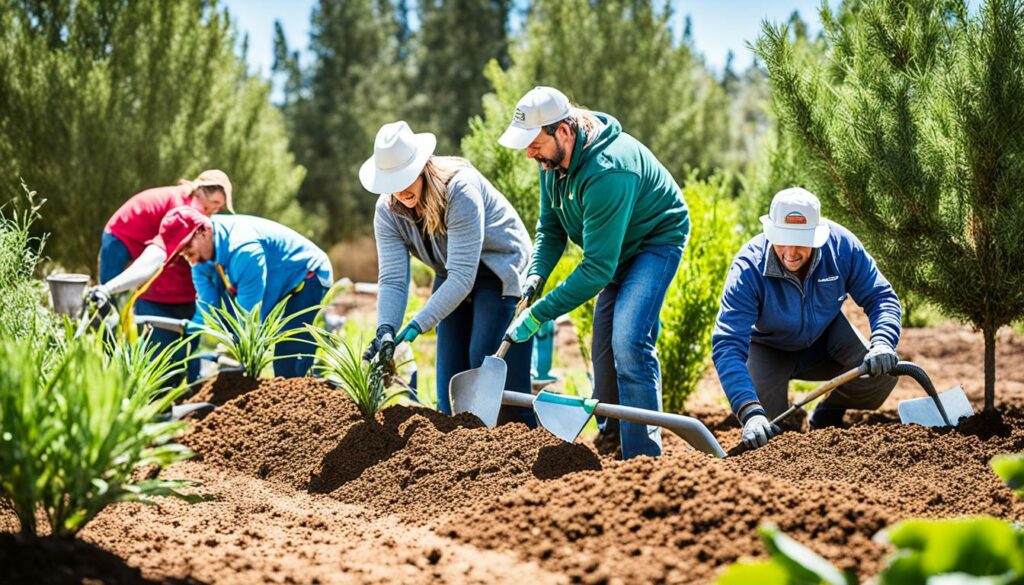
| Effects of Soil Degradation | Examples |
|---|---|
| Loss of Arable Land | Reduction in fertile soil due to erosion and salination |
| Decline in Biodiversity | Destruction of habitats, impacting flora and fauna |
| Decreased Crop Yields | Loss of fertility and organic matter affecting plant growth |
| Increased Flooding | Altered soil structure leading to poor drainage |
| Desertification | Transforming fertile land into desert-like conditions |
To beat soil degradation, we need to do a lot of things. We have to combine good farming with high-tech solutions. This, paired with global teamwork, will ensure our lands stay healthy. It’s for our earth, and it’s for our future.
Crop rotation strategies are key for good soil health and sustainable farming. They help keep the soil rich in nutrients, improve its structure, and deal with pests. This leads to better and more resilient crops.
Using crop rotation is great for the soil. It spreads out what kinds of crops grow in an area, so the soil doesn’t lose all of the same nutrients. This means less need for man-made fertilisers.
Growing crops like legumes can actually add nutrients back to the soil. This makes farming more sustainable and the soil healthier. Healthier soil keeps water better and stops it from washing the soil away.
The best crops to rotate change depending on where you are and what crops you grow. A common four-year rotation starts with legumes. It then moves on to root vegetables, fruits, and finally leafy greens. This pattern is good for keeping the soil healthy and the crops strong.
| Rotation Cycle | Crop Type | Benefits |
|---|---|---|
| Year 1 | Legumes | Nitrogen Fixation |
| Year 2 | Root Vegetables | Soil Aeration |
| Year 3 | Fruits | Enhanced Yield |
| Year 4 | Leafy Greens | Improved Soil Structure |
Adding grasses, cereals, and oil plants to the rotation can cut down on the need for chemicals and store more carbon. This helps produce more with fewer risks. Including animals in farming can also make the soil richer and help it hold water better.
Using crop rotation well takes knowledge and planning. With the right approach, farmers can improve the soil, grow better crops, and earn more money. It’s all about working with nature to farm in ways that are good for the land and for people.
Understanding maintaining soil fertility is key to sustainable agriculture. We need 70% more food by 2050, so we must use nutrients wisely. Integrated Nutrient Management (INM) combines organic and inorganic fertilisers with microorganisms.
This method boosts crop yields but protects the soil and avoids pollution.
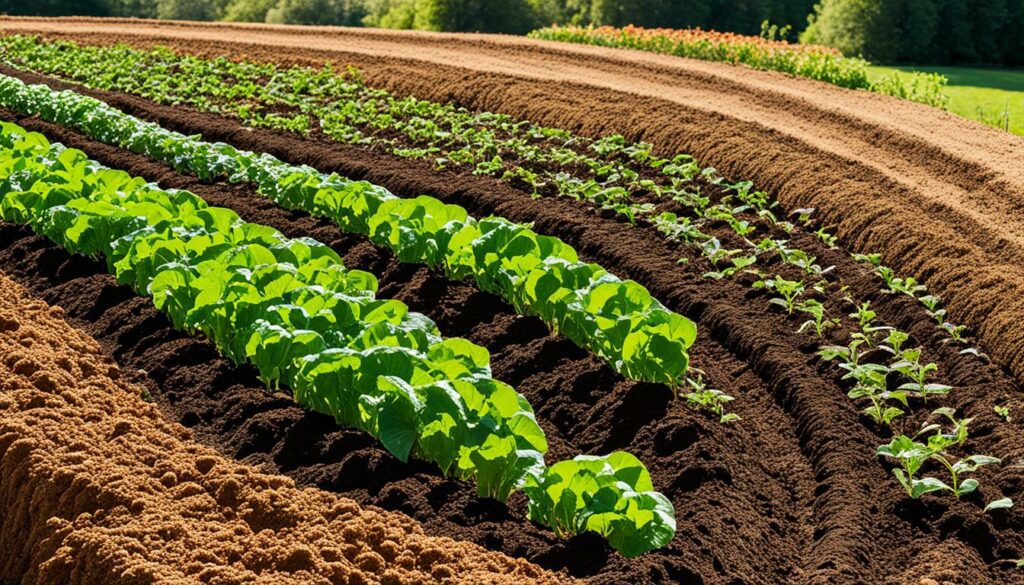
In places with poverty, using inorganic fertilisers is hard because of money or lack of them. Yet, people choose organic food even though it costs more. INM includes many practices like using compost and green manures. These help make the soil better without needing so many chemical fertilisers. This helps the earth, too.
Working together is key in INM. Farmers, scientists, the government, NGOs, and experts need to join forces. By combining their knowledge, unused lands can start growing food. This keeps farms efficient, profitable, and gentle on the environment.
INMs boost both soil health and sustainable agriculture. Look at India’s fertiliser market which could make 887 billion Rupees by 2026. Still, we face challenges like not having enough nutrients and causing pollution. Overcoming these challenges is crucial for a better future.
In agriculture, modern technologies are key to keeping our soil healthy. Things like remote sensing and precision agriculture help farmers a lot. They make it easier to take care of the land and keep it sustainable.
Remote sensing is crucial for checking soil health today. It uses satellites and drones to see if soil is in trouble. For example, Map My Crop shows farmers detailed maps for better decisions. And TerraRad uses drones to keep track of the topsoil, improving how we water crops.
Precision agriculture is all about doing just what the soil needs. It uses smart sensors and special tools to look after the land. For example, Farmsys‘ Soil Spectra watches soil closely. And N-Sense checks soil for nitrates. These help keep soil rich and healthy.
New tech in precision agriculture means farmers can give the land the exact nutrients and water it needs. Tools like soil robots from S-A-M Technologies and farming robots from Vertum Technologies are a big help. They make soil tests very accurate and reduce mistakes, making farming more effective.
These new ways of checking and caring for soil are fighting soil damage and making how we farm better. Thanks to new small companies, we’re making sure the earth stays good for growing food. They are very important for feeding the planet and keeping nature strong.
Lately, saving our soil has grabbed the world’s attention. The European Union plans to introduce a Soil Health Law by 2023. This law will keep our environment and health safe. It is part of a big soil plan aiming for 2050, to have strong and healthy soils. By putting this law in place, it shows how serious soil conservation is in fighting soil damage.
Since 1994, the United Nations Convention to Combat Desertification (UNCCD) has been a key player. It wants to stop desert growth and make our lands healthy by 2030. The EU and 197 other groups are working towards this. They aim to keep our lands productive. The Intergovernmental Panel on Climate Change (IPCC) also reminds us, through its 2019 report, that climate change feeds off of land damage.
Countries make their own plans to save their soil. The US, for example, brought in the 2018 Farm Bill. It has programs to help soil health, showing the US cares. Local groups and businesses also join forces to look after our lands. The Swinomish tribe in Washington has made changes to plans to fight climate change. They are focusing on keeping soils healthy, which is very important.
By getting the whole world and local areas together, we can do a better job protecting our soil. This is key for our planet. Soil gives us most of our food and is home to many species. By having strong rules, we can make sure saving soil matters to everyone. This protects our earth and our future.
Soil degradation means the quality of soil is getting worse. This makes it harder for plants and animals to live. It happens when soil loses its good physical, chemical, and biological properties.
This results in lower productivity, mainly seen in farming. It means soil can’t grow crops as well as before.
The main types include nutrient exhaustion and pollution. Also, there’s acidification, which makes soil too acidic. Desertification makes once-fertile land turn into deserts. Salinisation occurs when the salt level in the soil becomes too high.
Each type makes the soil less healthy for plants and animals. This affects how well they can grow and survive.
Natural elements like wind and water can erode soil. Human activities also harm it. These include deforestation and overgrazing, which make soil compacted. Urbanisation and industrial farming also lead to soil degradation by reducing the amount of organic matter.
When soil degrades, it starts to lose its ability to support crops. This leads to lower crop yields. Vital nutrients like phosphorus and potassium are often lost. Soil compaction makes it hard for crops to grow. This can increase the risk of food shortages.
Erosion is a key player in soil degradation. It wears away fertile soil through water and wind. This process also moves soil’s essential nutrients and organic matter away.
There are many. One is conservation agriculture, which minimises soil disturbance. Another is regenerative farming. This includes things like cover cropping and holistic grazing. These methods aim to make the soil healthier and fight soil degradation.
Cover cropping shields soil from erosion and adds organic matter. It helps keep the soil alive. No-till agriculture doesn’t disturb the soil as much. It keeps the soil structure strong and helps it absorb water better.
Planting vegetative barriers to break the wind is a good method. These barriers help prevent soil erosion. Terracing is another one. This method arranges land into steps to slow down water and reduce soil loss.
Agroforestry combines trees with crops or animals. It makes soil more stable and better at keeping water. This mix also protects from erosion. It increases biodiversity and fights against soil degradation.
Efforts to fight soil degradation include teaching people and promoting sustainable practices. The UNCCD’s Land Degradation Neutrality target is a big part of this. It aims to get everyone working together to save the soil.
Crop rotation keeps the soil full of nutrients, improves its structure, and stops pests. This method involves changing which crops are grown in each field. It helps the soil by giving it a variety of nutrients.
Integrated nutrient management uses both organic and inorganic fertilisers. It aims to keep nutrients balanced and the soil healthy. This method helps make farming sustainable over the long term.
Remote sensing and precision agriculture have made checking soil health easier. They help find areas where the soil is in bad condition. This allows farmers to use resources wisely, improving how they farm sustainably.
There are global and national rules for keeping soil healthy. These rules cover sustainable land use. They help make sure the soil is looked after well, from local farms to the whole world.